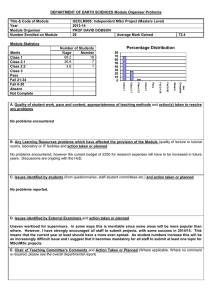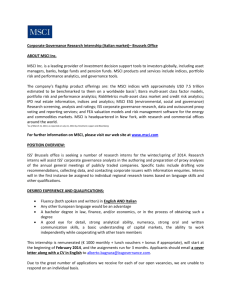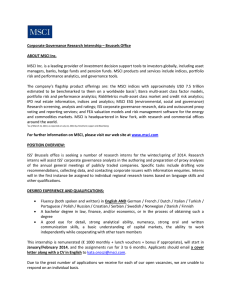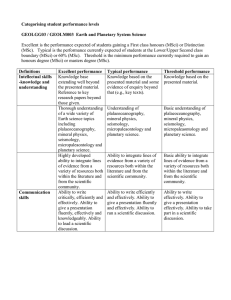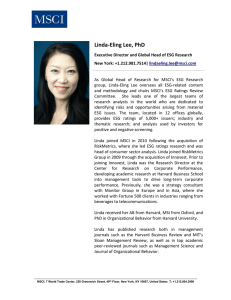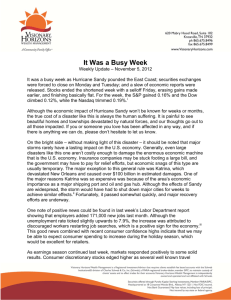On the Role of Financial ... Finance in Financial Stability and Economic Growth: 50
advertisement
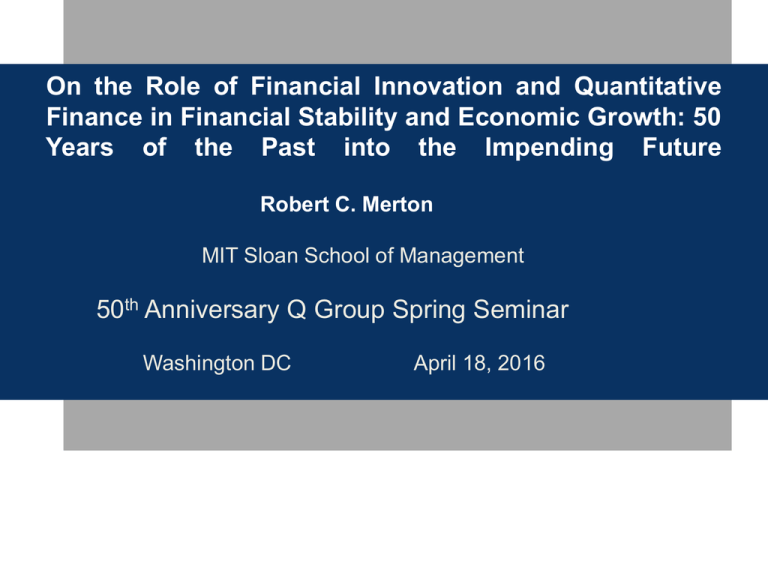
On the Role of Financial Innovation and Quantitative Finance in Financial Stability and Economic Growth: 50 Years of the Past into the Impending Future Robert C. Merton MIT Sloan School of Management 50th Anniversary Q Group Spring Seminar Washington DC v April 18, 2016 Overview of remarks • • • • • • • • • • Well-functioning financial system is essential for sustainable economic growth and development –RM Solow and D North https://www.ubs.com/microsites/nobel-perspectives/en/robert-solow.html Financial innovation drives improvement of the financial system Finance science, technology, and economic need drive financial innovation Crisis breeds implementation of innovation which leads to an improved financial system: observations from the 1970s in US Financial innovation can solve real-sector challenges: case of Leipzig gas pipeline in 1990s Derivative markets and quantitative finance tools are fundamental to a modern well-functioning financial system Derivative-based innovation : present and future Derivatives innovation can improve policy objectives implementation by removing unnecessary dysfunctional unintended “side effects” Country swaps can lower the cost of capital with increased global riskbearing of local risks without sacrificing local governance or taking capitalflight risk Future innovations to improve the global financial system and economic growth 2 Major Financial and Economic Crisis 1970s: Risk Explosion and Stagflation in USA • Multi-dimensional explosion of volatilities in the western economies reflected in financial systems • Fall of Bretton Woods currency system • First oil crisis in 1973-4 and a second one in 1979 • Double-digit inflation in the US highest since Civil War • High unemployment ~9%: • “Stagflation” unknown, and still unsolved, economic disease • Stock market fell 50% in real terms mid 1973 – 1974 • Double-digit interest rates , highest since Civil War • No mortgage money available: Regulation Q • 1973-1975 recession was really a 1970s recession because its effects extended into the 1980s Risk Explosion and Crisis 1970s Drives an Explosion of Extraordinary Financial Innovation in USA, Subsequently Adopted Throughout the World • • • • • • • • • • • • Option exchange: financial value insurance Financial futures for currencies, interest rates, stocks NASDAQ , first electronic stock market Money market funds, high-yield and floating rate bonds Index funds Stage Coach Fund 1970 & Vanguard 1975 TIAA-CREF international diversification in stocks 1972 ERISA 1974 modern employer-funded pension system May Day 1975 negotiated commissions & Vanguard created Debt securitization and creation of a national mortgage market Interest rate swap –eliminates the largest bank risk Eliminate destructive regulations: deposit rate ceilings Foundation set for globalization of capital markets: global diversification • Quantitative finance: portfolio theory; asset pricing models ; nonlinear derivative/option-pricing models; large-scale stock price data bases Using Contracts as Substitutes for Physical Assets for Greater Efficiency and a Greener World: Leipzig Gas Pipeline 1990s German reunification created rapid economic development and an increased power demand. To meet this demand, a natural gas power station in Leipzig had two options: Option 1 Spend $50M for a pipeline to the European gas grid and buy UK, Norwegian and Dutch gas at spot prices indexed off the USD price of heating oil at the Upper Rhine delivery point Option 2 Spend $300M for a new pipeline to connect to the Russian gas grid and enter a 15 year fixed price contract in Deutsche Marks 3 From Peter Hancock, AIG, 2014 Contractual Synthesis of Assets: Leipzig Gas Pipeline (cont.) Option 1 Option 2 Capital Investment $50M $300M Advantages Reduced political risk by avoiding dependence on Russians Lower capital investment Stable prices of power potentially useful to population accustomed to price controls Disadvantages Gas price volatility High capital investment Option 1 was more attractive with hedging, but had two significant problems: 1. Limited hedge instruments available: 2. 3. 4. 5. Crude oil call up to 5 years in USD Crude/heating oil basis swaps up to 2 years FX Options up to 5 years Currency swaps up to 10 years 2. Limited sophistication of the city administration Solution A bank provided a 15 year cap on European gas prices at a strike price equal to the Russian fixed price contract in exchange for a premium of $125 MM. The cap is effectively a “synthetic pipeline”. The price is half of the incremental cost of a physical pipeline to Russia and compensates the bank for hedge mismatches and the need to dynamically adjust hedges over 15 years. Source: Peter Hancock, AIG, 2014 4 Derivative Financial Innovation: Present and Future • Derivatives are efficient “adapters” between heterogeneous financial systems, which improve global financial integration and diversification • Derivatives provide efficient implementation of the three methods of managing risk: diversification, hedging and insurance • Derivatives permit efficient risk diversification while implementing other objectives by separating risk-bearing choices from comparative advantage, cash investment, governance, liquidity, expropriation, and tax issues. • Development of derivative markets for equities, interest rates, currencies and commodities promotes financial stability by multiple channels for risk transfer and information-extraction from prices • Derivatives can improve the efficiency of open-market and stabilization operations • Intelligent regulation to realize the benefits of financial innovation while 8 managing its risks. Capital Market Globalization Benefits Economic Growth Global Diversification Pays: A “free” Alpha • • • • • Three ways to manage risk: diversification, hedging and insurance Diversification is “free” and improving diversification is thus a “free” alpha The best-diversified portfolio is the World market portfolio The cost of not diversifying is measured in terms of a reduced Sharpe Ratio Asian experience 1993-2015 : Japan, China, Hong Kong, Singapore, Thailand, Malaysia, Indonesia, Philippines, and Korea • Portfolios of a superior-performing countries will generally benefit from global diversification • Conflicts with other policy objectives of the government: Implementation of policy objectives to protect against adverse capital flows, preserve domestic governance of industries , and channel investment into domestic industries often impose an “unintended” cost on domestic investors from inefficient diversification • Conflict solution: Derivative contracts can be used to reduce or eliminate this cost by altering risk flows instead of capital flows, while preserving the policy objectives 8 Capital Market Globalization Benefits Economic Growth Cost of Restricting Investing to Domestic Assets Only and Investor Home Bias Behavior Can be Substantial - China MSCI World versus MSCI China 1993-2015 Global Diversification Pays MSCI World versus MSCI China 1993-2015 10 MSCI China (expected) MSCI World 9 Sharpe Ratio=0.401 8 Expected Return % (annualized) Sharpe Ratio=0.194 7 MSCI China (actual) 6 Sharpe Ratio=0.095 5 4 3 US T-Bill 3-month 2 1 0 0 5 10 15 20 25 30 35 40 Standard Deviation % (annualized) • Source: MSCI China total return index, MSCI World total return index, U.S. 3 month T-Bill rate, 1993-2015. Returns in USD. “Expected” = expost 0-alpha, conditional on World realized return 1 Global Diversification Pays Even for a Superior-Performing Country MSCI World versus MSCI Korea 1993-2015 Global Diversification Pays MSCI World versus MSCI Korea 1993-2015 MSCI Korea (actual) 14 Sharpe Ratio=0.2799 Expected Return % (annualized) 12 MSCI World 10 Sharpe Ratio=0.4006 MSCI Korea (expected) Sharpe Ratio=0.2226 8 6 4 US T-Bill 3-month 2 0 0 5 10 15 20 25 30 35 Standard Deviation % (annualized) • Source: MSCI Korea total return index, MSCI World total return index, U.S. 3 month T-Bill rate, 1993-2015. Returns in USD. “Expected” = expost 0-alpha, conditional on World realized return 4 9 40 Capital Market Globalization Benefits Economic Growth Global Diversification Pays – Asian Experience 1993-2015 World • • • • • • • • • Japan China Hong Kong Thailand Malaysia Indonesia Singapore Philippines Korea Realized Alpha Realized Sharpe Ratio Expected Sharpe Ratio 0.00% 0.40 0.40 - 3.61% - 3.38% + 2.38% - 0.74% + 1.00% + 4.14% - 0.43% + 0.74% + 2.13% 0.08 0.10 0.36 0.19 0.21 0.29 0.26 0.21 0.28 0.27 0.19 0.26 0.21 0.18 0.19 0.28 0.19 0.22 8 Derivative Innovation for Better Policy Objectives Implementation Efficient Diversification of Risk, Governance, and Cash Capital Investment Objectives: Case of The Pension Funds of Canada Pens Before: 90% cash invested in Canada stocks and bonds required Canada Pension Return = Return on Canada 90% + Return World All Industries 10% Concentrated Risk Well-Diversified Risk Enter into a Total-Return Swap contract where Pension Liquidity, Expropriation, and Taxes Pays: Return on Canada ransformation & Separation of Asset Risks Receives: Return World All Industries Diversification, Governance, Liquidity, Expropriation, and After: 90% cash invested in Canada stocks and bonds required + swap Taxes Canada Pension Return = Return World All Industries 100% Well-Diversified Risk Copyright © 2016 by Robert C. Merton 12 Comparative Advantage vs. Efficient Risk Diversification: Managing Country Risk and Broaden Capital Base Using Country Swaps Before Taiwan Return = Return World Chip Industry + Return Taiwan-Specific Chip Concentrated generic risk Comparative-advantage risk Enter into a total-return Swap contract where Taiwan Pays: Return World Chip Industry Receives: Return World all Industries After: Taiwan Return = Return World All Industries + Return Taiwan-Specific Chip Diversified generic risk Comparative-advantage risk Copyright © 2016 by Robert C. Merton 13 Relative Advantage of Country Swaps for Diversifying Risk • • • • • • • • • • Lower Cost of Capital through increased global risk-bearing of local risks Can be combined to efficiently address another major country issue: Pension system design and reform and efficient risk-bearing Minimizes Moral Hazard of expropriation, repudiation, taxes or accounting Locals perform industrial governance, trading in shares in local market, receive benefits/losses of local-country-specific component of industry returns, thus avoids political risk of “selling off the crown jewels of the country” Credit Risk: no principal amounts at risk; set frequency of payments (.25, 0.5, 1.0 years); “right-way” contract [pay when country is better able]; potential for credit guarantee and/or two-way-marked-to-market collateral Policy is non-invasive: doesn’t require change in employment patterns and behavior, changes in industrial structure or changes in financial system design Policy is reversible by simply entering into an off-setting swap Robust with respect to local financial system design: works with capital controls, pay-as-you pension system, or no local stock market at all Insurance version: country swaptions How to measure country risk: Patterned after BIS model for banks Copyright © 2016 by Robert C. Merton 11 Future Innovations to Improve the Financial System and Growth • Employ bitcoin technology of hash functions and transaction block chains (global ledgers) to provide efficient non-centralized and simplified clearing and settling • Real estate and other title-search-sensitive transactions could be vastly simplified with potential huge cost reduction by transaction block chains technology • ECU-like diversification model for regional common currency to reduce local currency risk without the Euro-like risk • Using derivative market prices to extract forward-looking versus historical-based probability estimates to assess the impact of monetary and other government policy announcements on beliefs about the future and identify potential “hot spots” of connectedness. • Taking account of the interactions of monetary, fiscal and financial stability policies and unintended consequences of those policies 12 References Bodie, Zvi and Robert C. Merton, “International Pension Swaps”, Journal of Pension Economics and Finance, March 2002: 77-83. Merton, Robert C., “Country Risk”, Commentary, Risk Magazine, July, 1999. ______________, “Swapping Countries”, Insights, ICBI 2002 Conference Highlights, PricewaterhousCoopers, 2002 ______________, “Foreword: On Financial Innovation and Economic Growth”, Harvard China Review, (Spring 2004): 2-3. “International: Countries Can Gain by Swapping”, Briefs, Oxford Analytica, March 15, 2005, Oxford. Solow, Robert M., Nobel Perspectives, https://www.ubs.com/microsites/nobelperspectives/en/robert-solow.html . 12 Appendix Global Diversification Pays – Asian Experience 1993 – 2015 Japan China Hong Kong Thailand Malaysia Indonesia Singapore Philippines Korea 12 Capital Market Globalization Benefits Economic Growth-Japan MSCI World versus MSCI Japan 1993-2015 Global Diversification Pays MSCI World versus MSCI Japan 1993-2015 10 MSCI World Expected Return % (annualized) 9 MSCI Japan (expected) Sharpe Ratio=0.2689 Sharpe Ratio=0.4006 8 7 6 MSCI Japan (actual) 5 Sharpe Ratio=0.0768 4 3 2 1 US T-Bill 3-month 0 0 2 4 6 8 10 12 14 16 18 Standard Deviation % (annualized) • 1 realized return Source: MSCI Japan total return index, MSCI World total return index, U.S. 3 month T-Bill rate, 1993-2015. Returns in USD. “Expected” = expost 0-alpha, conditional on World 20 Capital Market Globalization Benefits Economic Growth-China MSCI World versus MSCI China 1993-2015 Global Diversification Pays MSCI World versus MSCI China 1993-2015 10 MSCI China (expected) MSCI World 9 Sharpe Ratio=0.401 8 Expected Return % (annualized) Sharpe Ratio=0.194 7 MSCI China (actual) 6 Sharpe Ratio=0.095 5 4 3 US T-Bill 3-month 2 1 0 0 5 10 15 20 25 30 35 40 Standard Deviation % (annualized) • Source: MSCI China total return index, MSCI World total return index, U.S. 3 month T-Bill rate, 1993-2015. Returns in USD. “Expected” = expost 0-alpha, conditional on World realized return 1 Capital Market Globalization Benefits Economic Growth-Hong Kong MSCI World versus MSCI Hong Kong 1993-2015 Global Diversification Pays MSCI World versus MSCI Hong Kong 1993-2015 14 MSCI Hong Kong (actual) Sharpe Ratio=0.356 Expected Return % (annualized) 12 MSCI World 10 Sharpe Ratio=0.401 8 MSCI Hong Kong (expected) Sharpe Ratio=0.263 6 4 US T-Bill 3-month 2 0 0 5 10 15 20 25 30 Standard Deviation % (annualized) • Source: MSCI Hong Kong total return index, MSCI World total return index, U.S. 3 month T-Bill rate, 1993-2015. Returns in USD. “Expected” = expost 0-alpha, conditional on World realized return 1 Capital Market Globalization Benefits Economic Growth-Thailand MSCI World versus MSCI Thailand 1993-2015 Global Diversification Pays MSCI World versus MSCI Thailand 1993-2015 12 MSCI Thailand (expected) 10 Expected Return % (annualized) Sharpe Ratio=0.2063 MSCI World Sharpe Ratio=0.4006 8 MSCI Thailand (actual) Sharpe Ratio=0.1865 6 4 2 US T-Bill 3-month 0 0 5 10 15 20 25 30 35 Standard Deviation % (annualized) • Source: MSCI Thailand total return index, MSCI World total return index, U.S. 3 month T-Bill rate, 1993-2015. Returns in USD. “Expected” = expost 0-alpha, conditional on World realized return 1 40 Capital Market Globalization Benefits Economic Growth-Malaysia MSCI World versus MSCI Malaysia 1993-2015 Global Diversification Pays MSCI World versus MSCI Malaysia 1993-2015 10 9 MSCI World MSCI Malaysia (actual) Sharpe Ratio=0.4006 Sharpe Ratio=0.2114 Expected Return % (annualized) 8 7 MSCI Malaysia (expected) 6 Sharpe Ratio=0.1764 5 4 3 2 US T-Bill 3-month 1 0 0 5 10 15 20 25 30 35 Standard Deviation % (annualized) • • Source: MSCI Malaysia total return index, MSCI World total return index, U.S. 3 month T-Bill rate, 1993-2015. Returns in USD “Expected” = expost 0-alpha, conditional on World realized return . 1 Capital Market Globalization Benefits Economic Growth-Indonesia MSCI World versus MSCI Indonesia 1993-2015 Global Diversification Pays MSCI World versus MSCI Indonesia 1993-2015 16 MSCI Indonesia (actual) Sharpe Ratio=0.2853 Expected Return % (annualized) 14 MSCI World 12 Sharpe Ratio=0.4006 10 MSCI Indonesia (expected) 8 Sharpe Ratio=0.1886 6 4 US T-Bill 3-month 2 0 0 5 10 15 20 25 30 35 40 Standard Deviation % (annualized) • Source: MSCI Indonesia total return index, MSCI World total return index, U.S. 3 month T-Bill rate, 1993-2015. Returns in USD. “Expected” = expost 0-alpha, conditional on World realized return 1 45 Global Diversification Pays MSCI World versus MSCI Singapore 1993-2015 Global Diversification Pays MSCI World versus MSCI Singapore 1993-2015 12 MSCI Singapore (expected) Sharpe Ratio=0.2788 MSCI World 10 Expected Return % (annualized) Sharpe Ratio=0.4006 MSCI Singapore (actual) 8 Sharpe Ratio=0.2616 6 4 US T-Bill 3-month 2 0 0 5 10 15 20 25 Standard Deviation % (annualized) • Source: MSCI Singapore total return index, MSCI World total return index, U.S. 3 month T-Bill rate, 1993-2015. Returns in USD. “Expected” = expost 0-alpha, conditional on World realized return 1 9 30 Global Diversification Pays MSCI World versus MSCI Philippines 1993-2015 Global Diversification Pays MSCI World versus MSCI Philippines 1993-2015 10 MSCI Philippines (actual) Sharpe Ratio=0.2089 MSCI World Sharpe Ratio=0.4006 9 Expected Return % (annualized) 8 MSCI Philippines (0 alpha) 7 Sharpe Ratio=0.1846 6 5 4 3 2 US T-Bill 3-month 1 0 0 5 10 15 20 25 30 Standard Deviation % (annualized) • Source: MSCI Philippines total return index, MSCI World total return index, U.S. 3 month T-Bill rate, 1993-2015. Returns in USD. 1 35 Global Diversification Pays MSCI World versus MSCI Korea 1993-2015 Global Diversification Pays MSCI World versus MSCI Korea 1993-2015 MSCI Korea (actual) 14 Sharpe Ratio=0.2799 Expected Return % (annualized) 12 MSCI World 10 Sharpe Ratio=0.4006 MSCI Korea (expected) Sharpe Ratio=0.2226 8 6 4 US T-Bill 3-month 2 0 0 5 10 15 20 25 30 35 Standard Deviation % (annualized) • Source: MSCI Korea total return index, MSCI World total return index, U.S. 3 month T-Bill rate, 1993-2015. Returns in USD. “Expected” = expost 0-alpha, conditional on World realized return 4 9 40
